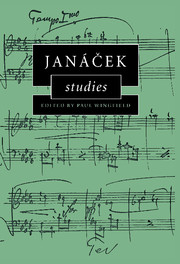Book contents
- Frontmatter
- Contents
- Preface
- 1 Expressive sources and resources in Janáček's musical language
- 2 ‘Nothing but pranks and puns’: Janáček's solo piano music
- 3 Narrative in Janáček's symphonic poems
- 4 Evasive realism: narrative construction in Dostoyevsky's and Janáček's From the House of the Dead
- 5 Direct discourse and speech melody in Janáček's operas
- 6 Kundera's eternal present and Janáček's ancient Gypsy
- 7 Janáček's folk settings and the Vixen
- 8 Janáček's operas in Australia and New Zealand: a performance history
- 9 Janáček's Moravian publishers
- 10 Janáček, musical analysis, and Debussy's ‘Jeux de vagues’
- Index
4 - Evasive realism: narrative construction in Dostoyevsky's and Janáček's From the House of the Dead
Published online by Cambridge University Press: 22 September 2009
- Frontmatter
- Contents
- Preface
- 1 Expressive sources and resources in Janáček's musical language
- 2 ‘Nothing but pranks and puns’: Janáček's solo piano music
- 3 Narrative in Janáček's symphonic poems
- 4 Evasive realism: narrative construction in Dostoyevsky's and Janáček's From the House of the Dead
- 5 Direct discourse and speech melody in Janáček's operas
- 6 Kundera's eternal present and Janáček's ancient Gypsy
- 7 Janáček's folk settings and the Vixen
- 8 Janáček's operas in Australia and New Zealand: a performance history
- 9 Janáček's Moravian publishers
- 10 Janáček, musical analysis, and Debussy's ‘Jeux de vagues’
- Index
Summary
Tolstoy famously regarded The House of the Dead (1860–1) as Dostoyevsky's finest work; indeed, he elevated it to a supreme position among nineteenth-century books written by Russian authors:
I have read The House of the Dead … I do not know a book better than this in all our literature, not even excepting Pushkin. Not its tone, but its point of view is admirable: sincere, natural and Christian. A good, instructive book.
This verdict significantly makes no reference to The House of the Dead as a novel; and George Steiner has indeed suggested that it reflects the fact that the book is the least ‘Tolstoyan’ of all Dostoyevsky's works – not really a novel at all, but ‘plainly an autobiography’. In this he takes his cue from Tolstoy himself, for in a postscript to War and Peace, Tolstoy categorised both The House of the Dead and Gogol's Dead Souls as works that cannot properly be called novels. The work's full title, Notes from the House of the Dead, itself in some respects confirms the work's distance from the novel genre, and in his massive biography of Dostoyevsky, Joseph Frank is, signicantly, content to use The House of the Dead as a primary source for the sections on the author's imprisonment. Thus, at the outset, there are some uncertainties attaching to The House of the Dead.
- Type
- Chapter
- Information
- Janácek Studies , pp. 56 - 78Publisher: Cambridge University PressPrint publication year: 1999



